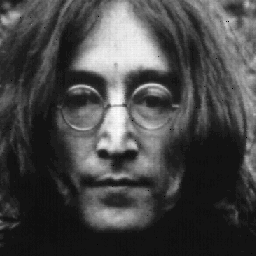WaveThresh3.


The animation begins with the source image. This is the
![]() Lennon image which is provided as a test image within
Lennon image which is provided as a test image within
WaveThresh3.
Then I applied the two-dimensional wavelet transform to the source image. In WaveThresh3 this can be done using the imwd function. It extracts information from the source image at different scales, locations and orientations. The WaveThresh3 imwd function is an implementation of Mallat's two-dimensional discrete wavelet transform (see Mallat, 1989).
When the source image shrinks to the top-left and becomes one-quarter of the original's area I add in the horizontal (top-right), diagonal (bottom-left) and vertical detail. These are wavelet coefficients corresponding to the finest scale at the three different orientations specified by Mallat's algorithm. Immediately the wavelet coefficients appears the top-left image becomes the source image to the next step in the algorithm.
This new coarser representation of the Lennon image itself is subjected to a multiresolution or wavelet analysis and when this image has shrunk to one-quarter of its size the remaining space is taken up with horizontal, diagonal and vertical detail of the coarsened image: i.e. detail at the finest but one scale. This process repeats over and over in the animated GIF.
The animated GIF itself was produced from GIF files using Peter Hartley's InterGif software.. The GIF files were produced using the public domain ImageMagick package to convert MIFF files produced from within S+ using my "S-Plus image software".